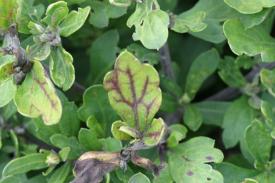
Glyphosate Herbicide Injury
9 pictures total.



Glyphosate herbicide drift on mum.
|
| Severity: |
varies out of 5 |
| Frequency: |
out of 5 |
| Symptoms: |
This herbicide inhibits a key enzyme in the amino acid synthesis pathway.
- glyphosate (Roundup, Touchdown, etc)
Characteristics of activity:
- Nonselective.
- Translocated in both xylem and phloem.
Symptoms of injury:
- Slow chlorosis/necrosis of plant tissue.
- Symptoms typically appear in 10 to 14 days after exposure.
- A change in flower color may be noticed.
- Stunting
|
| Cycle: |
|
| Management: |
- Read and follow all label directions.
- Use caution when applying herbicides around plants as desirable plants may be sensitive and injury may result.
- Do not spray during cool, wet weather as herbicide is metabolized slower at these times.
- Do not spray when wind speed and direction are such that herbicide drift is likely to occur.
- Affected plants may or may not survive herbicide drift; it depends on both the degree of exposure and the plant's tolerance to the herbicide.
- Water and fertilize plants as needed to promote good plant health.
- Illinois residents: If you suspect herbicide injury as a result of off-target movement from a nearby application and you are interested in filing a complaint with the Illinois Department of Agriculture, call the Illinois Department of Agriculture's Bureau of Environmental Programs at 1-800-641-3934. To learn more about spray drift and the formal complaint process, visit the Illinois Pesticide Safety Education Spray Drift Resources website.
- Non-Illinois residents: If you are interested in filing a complaint, contact your state pesticide control official via the Association of American Pesticide Control Officials website.
|
| Associated shrubs: |
|

